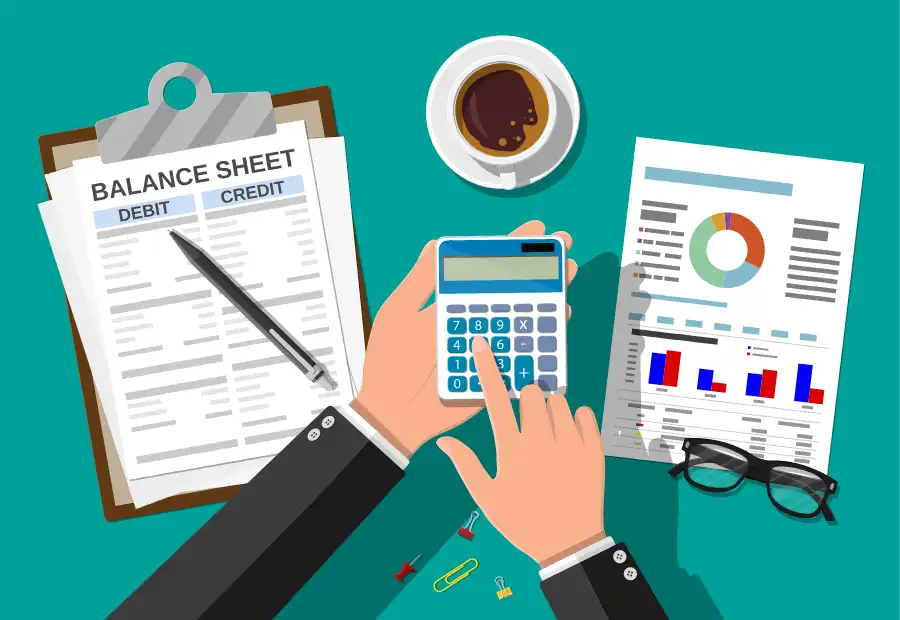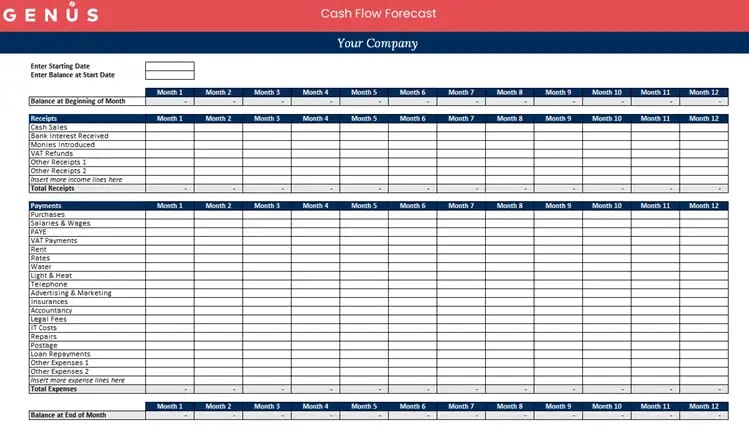
Cash is the lifeblood of a business. A cashflow forecast enables you to accurately estimate the flow of cash coming in and going out of your business for specific time periods, which is vital for both growth and sustainability.
Why is cashflow forecasting so important?
An accurate cashflow forecast is an invaluable tool for your business for a variety of reasons, such as:
- Your cashflow forecast adds planning and forethought to finances, which is especially useful for a business that is spending a lot of cash in order to achieve growth.
- The forecast will give you an indication of where and when your surplus cash will become available or if there is a potential upcoming deficit.
- Cash shortages, especially in uncertain economic times or periods of high inflation, are a very common obstacle faced by businesses.
- Cashflow forecasting helps you better anticipate these cash shortages, providing early warning signs, and giving you more time to plan for difficult periods.
- Cashflow forecasting helps businesses keep on top of any debts they may have.
- These larger outgoings require planning, and an accurate forecast can help you ensure cash is always available to keep up with repayments. It can also help you pay off debts faster. Lenders may require you to have a cashflow forecast so having one prepared already reduces delays and barriers to lending.
- Scenario planning is a key part of business strategy, and a robust and accurate cashflow forecast will enable you to explore these “what if?” scenarios with confidence in the numbers, allowing you to take advantage of key opportunities and help support your growth.
What makes up a cashflow forecast?
A basic cashflow can be produced by combining income and expenditure from different sources. There may be other elements to bring in, depending on the complexity of the business. The most basic cashflow, however, requires the following:
- Sales forecast: Understand and project monthly income from multiple sales channels.
- Expenditure forecast: Forecast monthly expenses and overheads in order to project monthly net profit.
- Cashflow forecast: This combines the income and expenditure to get a cash surplus/deficit per month.
What is a sales forecast?
An important starting point when producing a cashflow forecast is the sales forecast.
Income can come from different sources and can relate to different periods. For example, you could have regular monthly income, one off income and inconsistent income that varies.
The key is to consider all sources and predict (even if this seems difficult) income from all streams. You could consider having multiple forecasts – a base case (average scenario), worst case (most serious outcome), best case (ideal projected scenario).
Sales forecast example
Your sales forecast should have a row for each different sales channel of your business, and the estimated monthly revenue total for each will populate the columns.
| April | May | June | July | Aug | |
| Sales Channel 1 | 100 | 100 | 150 | 150 | 100 |
| Sales Channel 2 | 50 | 60 | 60 | 60 | |
| Sales Channel 3 | 200 | 150 | 100 | ||
| Total | 100 | 150 | 410 | 360 | 260 |
You should aim to anticipate seasonal variance in relevant sales channels (such as Sales channel 1 in the above example). Likewise, you should also include new product launches, which may see an initial spike in sales, followed by a reduction before levelling out.
Every sales channel will have its own unique circumstances that must be considered, and a mini sales forecast allows you to gather them all in one place to inform the overall cashflow forecast.
What is an expenditure forecast?
An expenditure forecast does exactly what the name suggests; it helps you track your expenses by considering the outgoings (day to day running costs, expenses, debt repayments, etc).
Ensure that you consider the different elements of your business where you may need to spend cash – bringing in annual or one-off payments.
Expenditure forecast example
| April | May | June | July | Aug | |
| Postage & Packaging | 10 | 10 | 10 | 10 | 10 |
| Website Management | 20 | 20 | 20 | 20 | 20 |
| Office Supplies | 10 | 15 | 20 | 25 | 10 |
| Software packages | 10 | 10 | 10 | 10 | 10 |
| Total Expenditure | 50 | 55 | 60 | 65 | 50 |
Summary cashflow forecast
Now that you have produced the sales and expenditure forecasts, you will need to combine the two by bringing in the total sales projections by month, as determined by your sales forecast, and deduct any monthly overheads or other costs.
What is an example of a cashflow forecast?
Now that you have accurate sales and profit and loss forecasts, you can combine these to generate your full cashflow forecast.
Your sales (or “receipts”) are forecast for each month, and all expenses deducted to provide an estimated balance at the end of each month.

A cashflow forecast should focus on how cash moves during the different stages of a business’s product/service lifecycle. It should identify any potential pitfalls or difficult periods.
Your cashflow forecast enables you to see the financial implications of business plans from a cash perspective, but also a finance and tax perspective. If, for example, you were to consider seeking funding, this would be vitally important.
A free Excel template of a complete Cashflow Forecast can be found in our free Genus Diversification Toolkit or can be downloaded for free.
Cashflow forecasting tools and software
Your cashflow forecasting can be fully integrated with your finance function through a variety of tools and software.
Xero, for example, is a cloud-based accounting platform that allows businesses to manage finances in real time, informing their cashflow forecasts with bills and invoicing, VAT, expenses, payroll, bank reconciliation, management reporting, and more.
Another very useful tool that is a part of the Xero library is Fathom, which lets you effortlessly create cashflow forecasts that are informed by your accounts within Xero.
Learn more about using Xero for cashflow forecasting and other financial tasks.
How far ahead should a cashflow forecast look?
For a cashflow forecast, you should aim to plan as far into the future as you can predict with a certain degree of accuracy. Some businesses, particularly those that are larger with a well-established finance function, will have sufficient data to predict quite far into the future.
Businesses with less data available will need to balance accuracy with forecasting time. The further ahead the cashflow forecast goes, the less accurate it will be.
If you are using accounting software, such as Xero, there are web applications that can use historic data and perform smart predictions to create simple forecasts over a longer period of time.
Do you need budgeting and cashflow forecasting assistance?
Cashflow Forecasting is vital as it provides insight into where the cash is going in the business and any potential dips where it appears you may struggle, providing you time to find funding or consider other ways to improve your cashflow.
The Genus team at Shorts can help to create this forecast as well as helping you find funding if needed. Our Management Reporting service provides accurate, timely information on your business, enabling you to make better business decisions. Speak to us today for a free consultation.

Alicia Williams
I am the Director of the Genus team at Shorts, a chartered certified accountant and Xero specialist. I specialise in cloud-based accounting solutions, particularly Xero and add-on software, helping clients streamline processes and improve efficiency. As a Client FD, I work closely with businesses to give them a clear understanding of their current position and support their long-term planning and growth.
View my articles

